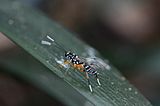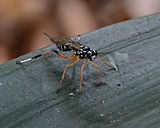Lemon tree borer parasite facts for kids
Quick facts for kids Xanthocryptus novozealandicus |
|
|---|---|
 |
|
| Lemon tree borer parasite on blackberry leaf | |
| Scientific classification | |
| Kingdom: | |
| Phylum: | |
| Class: | |
| Order: | |
| Family: |
Ichneumonidae
|
| Subfamily: |
Cryptinae
|
| Genus: |
Xanthocryptus
|
| Species: |
X. novozealandicus
|
| Binomial name | |
| Xanthocryptus novozealandicus (Dalla Torre, 1902)
|
|
The lemon tree borer parasite (Xanthocryptus novozealandicus) is a type of wasp. It belongs to the Ichneumonidae family. This wasp is native to New Zealand. You can also find it in Australia and New Guinea.
Female wasps look for wood-boring beetle larvae in March. One of their favorite targets is the lemon tree borer. This beetle tunnels into citrus trees, grape vines, and many native plants. When a female finds a good host, she uses a special tube called an ovipositor. She pushes this tube through the wood and lays her eggs inside the beetle grub. This helps control some pests that damage trees. X. novozealandicus prefers to lay eggs in larger, second-year lemon tree borer larvae.
Contents
What Does the Lemon Tree Borer Parasite Look Like?
Female X. novozealandicus wasps are larger than males. Females are usually between 9 and 15 millimeters long. Males are smaller, measuring 5 to 11 millimeters.
These wasps are mostly black. They have white spots on their thorax (the middle part of their body). They also have white stripes on their abdomen and head. Their front legs are short. Their back four legs are much longer and are reddish-brown with black tips. The two back legs each have a single white band.
Their antennae are very long and black. They have a clear white band near the tip, but the very end is black. The wasp uses the white part of its antennae to feel damaged wood. This helps it find a good host. The wasp's colors are a type of warning coloration. This helps protect them from birds. The wasp can also copy the colors and flight of its prey. This trick helps the wasp get closer to its host without being noticed.
- Xanthocryptus novozealandicus
Life Cycle of the Lemon Tree Borer Parasite
The life cycle of X. novozealandicus has four stages. These are egg, larvae, pupae (inside a cocoon), and adult. Scientists do not yet know how long it takes for the wasp to fully grow.
The Lemon Tree Borer Parasite needs beetle larvae to raise its young. In March, female wasps search for hosts to lay their eggs. They can see damage on tree bark that wood-boring beetles have made. The wasp gets its name from its common host, the Lemon Tree Borer.
Researchers think their long antennae help them find beetle larvae. They can sense the larvae even if they are deep inside the wood. Females use a special tube called an ovipositor. This tube is sharp enough to go through the wood and into the beetle grub. Once inside, the wasp quickly lays its eggs. As the X. novozealandicus larvae grow, they eat carefully. They do not kill their host right away.
Where Do Lemon Tree Borer Parasites Live?
Global Range
X. novozealandicus is native to New Zealand, New Guinea, and Australia.
New Zealand Range
You can find this wasp all over New Zealand. It lives on both the North and South Islands. It is also found on the Three Kings Islands.
On the North Island, they live in Northland, Auckland, The Bay of Plenty, Manawatū-Whanganui, Waikato, Hawke's Bay, and Wellington. On the South Island, they are seen in Tasman, Nelson, the West Coast, and parts of Canterbury and Otago. They live in natural forests and small clearings.
Habitat Preferences
Not much is known about where X. novozealandicus prefers to live. However, the Ichneumonidae family, which it belongs to, lives in most land environments. They just need their host species to be present.
What Do Lemon Tree Borer Parasites Eat?
Diet and Parasitism
Wood boring beetles are the main food source for the wasp larvae. Adult parasitic wasps usually eat nectar, pollen, and honeydew.
X. novozealandicus, like all Ichneumon wasps, are very helpful to farming. This is because they mostly parasitize pest species. The Lemon Tree Borer (Oemona hirta) is a common farm pest. It damages grape vines and citrus trees. So, this wasp helps control these pests. In Auckland, about 10-20% of Lemon Tree Borers have been found to host the wasp's larvae.
Predators
We do not know much about specific animals that hunt X. novozealandicus. However, like most wasps, they can be eaten by birds.
Diseases
Currently, there are no known diseases for X. novozealandicus.
Other Interesting Facts
X. novozealandicus has two other similar wasps in New Zealand. These are Campoplex sp. and Apsicolpus hudsoni. It was once thought that these three wasps would compete for the same hosts. However, Campoplex sp. and Apsicolpus hudsoni prefer smaller larvae. The other two wasps also have longer ovipositors. This allows them to reach hosts deeper in the tree bark than X. novozealandicus.
Scientists have found that female wasps lay female eggs in larger hosts. They lay male eggs in smaller hosts. This is likely because female wasps are bigger and need more food to grow.



